Mapping an indentured labour route in South Africa
Legacy
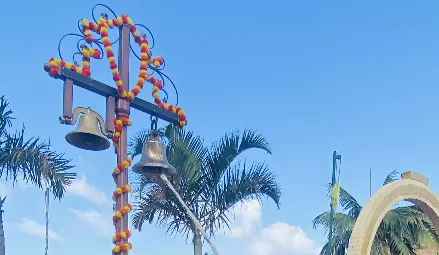
Women from Mount Edgecombe ring the bell in tribute to indentured workers at the unveiling of the Bell Tower over the weekend.
Image: Selvan Naidoo
IN CAPE Town, four walking trails trace the history of slavery from where the first slaves set foot upon those shores, to where they lived, the sufferings they endured, and the profound contributions they made to the building of Cape Town and the unique cultural heritage of the Western Cape.
Listed on the route of the walking trail is the Iziko Slave Lodge, the most prominent marker of slave history, which now serves as a museum dedicated to human rights and the legacy of slavery in South Africa.
The Slave Lodge was built in 1663 to accommodate slaves next to the Dutch East India Company's Garden, where many Indian slaves worked. Other sites of slave consciousness include Church Square, where a raised dais near the Slave Lodge marks the spot where slaves were auctioned.
A slave bell at Oranjezicht Farmstead is featured at the small park on a site where the 18th-century farmstead's barn and the slave bell tower are still retained as Cape Town’s sites of conscience to memorialise slave history. The bell reminds us of a time when ships came into the bay and were rung for slaves to come running, fetching baskets of fresh fruit from the farm, and then heading down and sell to the new arrivals.
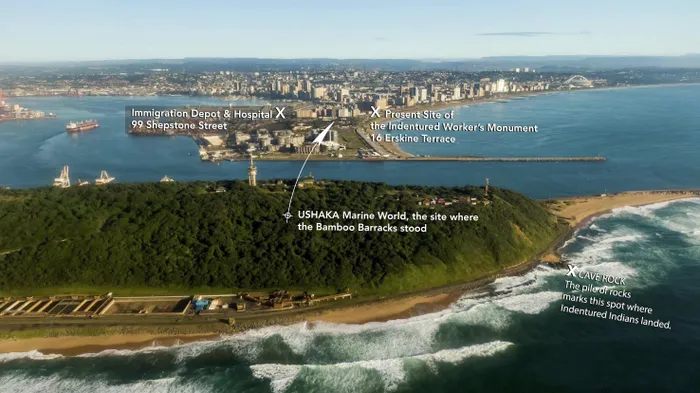
An aerial Map of the Bluff and the Point areas that marks sites of the Indentured Labour Route Mapping Project.
Image: Selvan Naidoo
A prominent feature of many slave plantations, the bell tower structures that housed bells used to regulate the daily lives of enslaved people, served as a means of surveillance over the enslaved population, becoming a symbolic feature of plantation architecture and landscape.
For KwaZulu-Natal, the indentured labour system that brought 152 184 Indian workers to Africa from 1860 to 1911 to advance an ailing colonial economy of Natal, barely has any recognisable sites of conscience that mark where the indentured workers had landed, where they were processed, and where they lived.
In recent years, ongoing research to map an indentured labour route in KwaZulu-Natal is being led by the author of this column to memorialise the built environment that was shaped by the system of indentured labour, particularly in the context of Indian indentured migration to South Africa. These sites include not only the physical structures built for and by indentured workers, such as housing and infrastructure, but also the broader impact on urban and rural landscapes, as well as the cultural heritage associated with architectural objects and spaces.
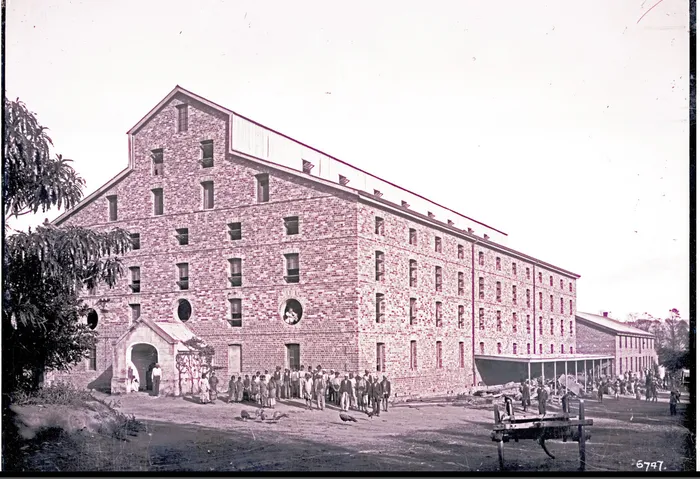
Kearsney Tea Estate Factory at Stanger.
Image: 1860 Heritage Centre
The research and mapping project narrows its focus to include indentured labour depots in India, coastal port sites where the indentured workers had disembarked and first landed to plantation and barracks accommodation to towns of settlement to educational sites of conscience and to religious and cultural sites of memory that will culminate in mapping an Indian Indentured Labour Route for South Africa along the lines of the slave route in Cape Town.
In Durban, one of the key sites identified for the mapping project is the landing site that locates the exact spot where indentured Indians first landed is situated to the south of the Bluff, near the site of the now destroyed Cave Rock, where the Truro docked on November 16, 1860.
A Mercury report noted that “the Truro arrived on the evening of the Friday, 16th November 1860, taking everyone unawares, although it had been officially daily expected” since November 12. The barracks were unfinished, and Edmund Tatham (the 2nd “Coolie Immigration Officer”) was upcountry. Philip Allen, the Colonial Treasurer, took charge; he hurried on the building of the barracks; landed the Indians on November 17 after disembarking from the Truro after the Health Officer, Dr Holland, had given them a clean bill of health...”
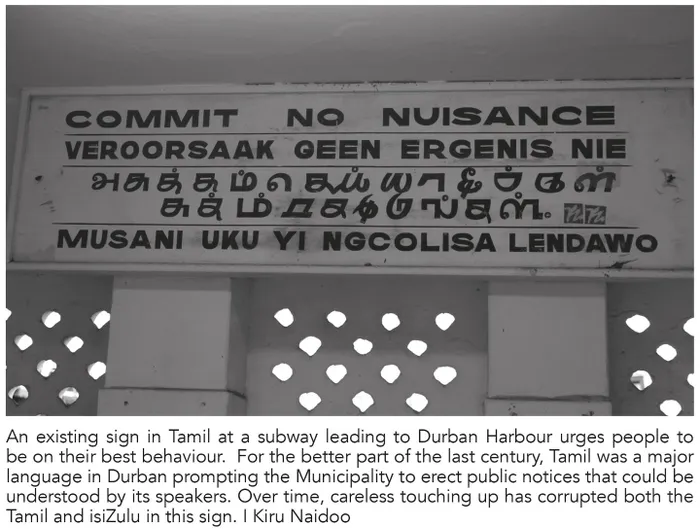
An existing sign in Tamil at a subway leading to Durban Harbour urges people to be on their best behaviour. For the better part of the last century, Tamil was a major language in Durban prompting the municipality to erect public notices that could be understood by its speakers. Over time, careless touching up has corrupted both the Tamil and isiZulu in this sign.
Image: Supplied
“Matters were complicated by the arrival on 26 November 1860 of the 2nd shipment of indentured labourers aboard the Belvedere, which sustained twenty-four deaths from cholera during the voyage. Durban became alarmed as more deaths occurred in the port, and the Colonial Secretary and Colonial Treasurer hastened there, ordering the accommodation of the Belvedere passengers in a Lazaretto hastily erected on the Bluff on the southern side of the harbour, away from town.”
At Mauritius, where the great experiment of Indian indenture started after the abolition of slavery in 1834, indentured immigrants walked up the "Immigrant Steps", where thousands of workers ascended into the immigration depot at Port Louis. The Coolie Ghat was proclaimed as a National Monument in April 1987, elevating the status of the site as an essential marker of Mauritian cultural heritage.
In November 1989, the term "Coolie Ghat" was officially changed to "Aapravasi Ghat" because of the derogatory connotation attached to the word "Coolie". The same year, the Government of Mauritius established a plan for the restoration of the Aapravasi Ghat to pay tribute to the memory of the Indian indentured labourers and to preserve the historic features as a key landmark and site of conscience for the nation.
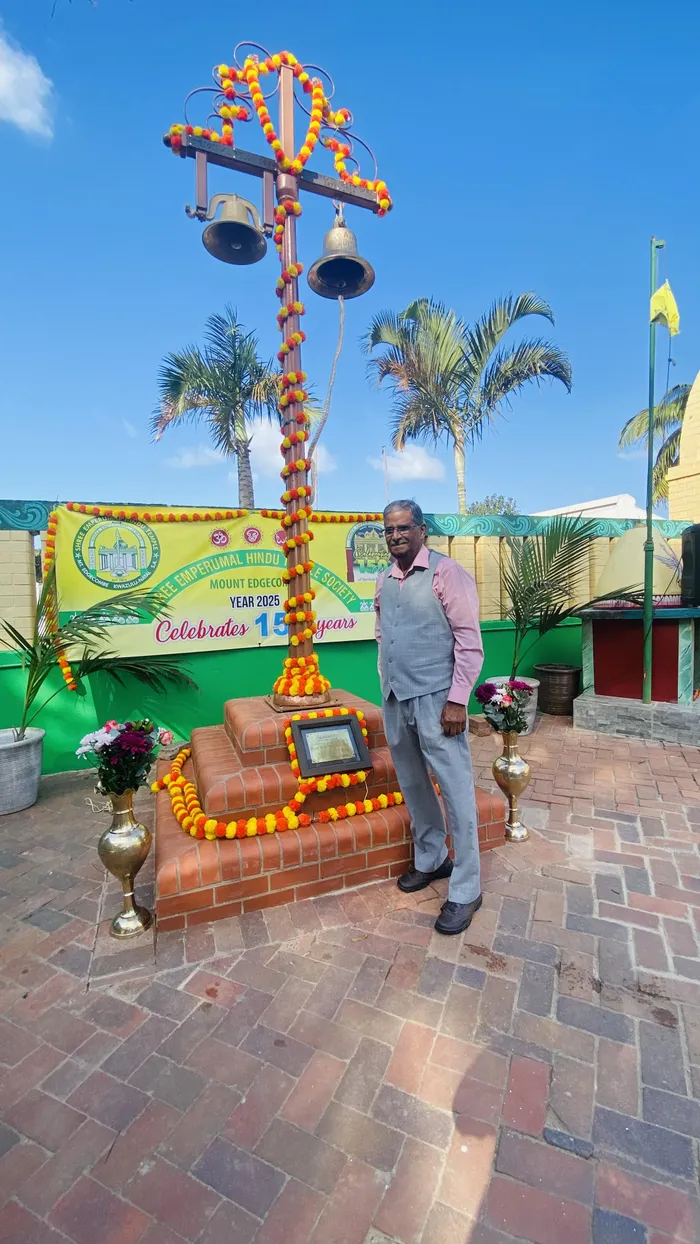
Sunny Pillay, the archivist of Shree Emperumal Temple in Mount Edgecombe, at the unveiling of the reconstructed Bell Tower.
Image: Selvan Naidoo
As the Aapravasi Ghat holds universal, cultural, and historical values, expressed in its Outstanding Universal Value (OUV), the site was inscribed on UNESCO's World Heritage Site List on July 12, 2006.
In the Caribbean, the Trinidad indentured arrivals were lodged at Nelson Island in 1845. In Natal, Indian indentured workers first landed at the Bluff. According to Andrew Macdonald of the University of Witwatersrand, Department of History,
“… because quarantine measures required a demonstrable outbreak, other sites of isolation appeared around the lagoon for more routine disembarkations. In Durban, harbour staff built a barracks on the Bluff for the first shipments and enclosed it with a higher wall in 1862, where immigrants stayed for up to three months to await assignments. Around 1864, a new Indian immigration depot opened at the Point, some 800 metres west of the Customs House.”
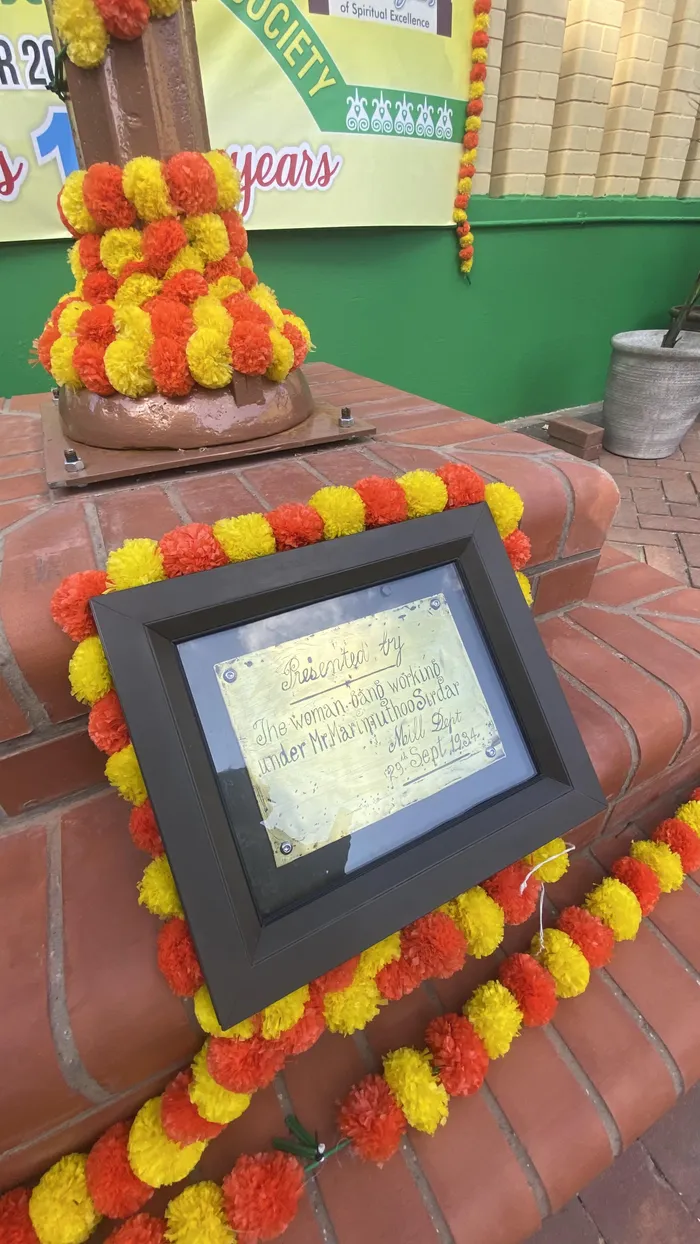
The original plaque highlighting the donation of the bell tower by the Woman Gang working under Marimuthoo Sidar at the Mill Barracks in 1934.
Image: Supplied
South Africa’s own Aapravasi Ghat, a site unknown to many, is presently located where the Point Branch Court in 99 Shepstone Street stands today. The Immigration Depot and Hospital marks a primary site of conscience in mapping the Indentured Labour Route project for South Africa. The site is located at Addington, consisting of 4 lots, with the total frontage at Shepstone Street being 131 meters with a depth of 61 meters, and the total area of the 4 lots being 2 acres.
The land is close to the Railway Line, facing St Paul's Wharf. The property was leased by the Indian Immigration Board from the Colonial Government of Natal on a perpetual lease and at a nominal rent, with the property’s value estimated at £28 000 in 1908.
The Immigration Depot was the site where thousands of indentured workers were kept for allocation to colonial planters or employers after they arrived from Madras or Calcutta. It was the site where indentured workers spent days waiting for ships to board, going back to India when their residential contracts of ten years in the colony had ended, giving them free passage for their return.
Thousands of archival files exist documenting child and adult deaths at the depot, the unsanitary conditions of the depot, plague evacuation correspondence of 1903 at the depot, hospital correspondence, and "invalids" being kept at the depot for return to India. The Immigration Depot and hospital mark a primary site of conscience on the map of indentured routes for South Africa. Other sites of the indentured labour routes point to objects that shape infrastructure with an existing sign in Tamil at a subway leading to Durban Harbour that urges people to be on their best behaviour.
For the better part of the last century, Tamil was a major language in Durban, prompting the municipality to erect public notices that could be understood by its speakers. Over time, careless touching up has corrupted both the Tamil and isiZulu in this signage that is still seen today at the Durban esplanade.
In Phoenix, to the north of Durban, stand banyan trees in Saccharine Hill Estate, located in unit 17, Grandmore, Phoenix. These beautiful tree saplings were brought on ships and planted in a circular formation resembling a village council by our indentured ancestors stand tall and proud some 165 years since the first 342 indentured passengers arrived in 1860. The site is a living memorial to the spirit of determination, hard work that will be mapped as a site of conscience on the Indentured Labour Route of South Africa.
A major religious architectural marker of indentured identity is located at the only existing link to the first indentured ship, SS Truro, that arrived on November 16, 1860. The tomb of passenger number 282, Sheik Ahmed, who hailed from Chitoor, North Arcot, Madras Presidency, is located at the shrine of Hazrat Sheik Ahmed Badsha Peer next to the Brook Street Cemetery in central Durban. Badsha Peer was posthumously conferred the title of great saint for enthralling people with his spiritual following and healing gifts. The shrine of Hazrat Sheik Ahmed Badsha Peer remains a place of pilgrimage for people of all faiths and races in Durban.
During the past weekend, the oldest temple in South Africa, built in 1875, the Shree Emperumal Temple in Mount Edgecombe, marked its incredible 150th anniversary with the unveiling of a bell tower that was first donated by the woman "gang" working under Mr. Marimuthoo Sidar at the Mill Department on September 23, 1934.
In tribute to the resilience of their indentured forbears, the temple committee reconstructed the bell tower with the original bell being erected alongside the temple bell as a marker of indentured labour in the town of Mount Edgecombe. As we move forward, other religious and cultural sites will be mapped, alongside places like the Sezela Mill, the Amatikulu Mill, all the former sites of indentured labour barracks like the Knipe Street barracks in Pietermaritzburg, the ruined tea estate factory in KwaDukuza, and other sites that make up the indentured labour route mapping project.
In ensuring we avoid colonial erasure, eminent scholar on indentured studies, Professor Crispin Bates, writes that the exclusion of minority history "disables" people from making a positive contribution to building meaningful societies. This disablement in colonial and apartheid South Africa sees scant acknowledgment of indentured labour and its role in advancing the ailing economy of colonial Natal.
Etched in memory, the Indentured Labour Route Mapping Project ensures that the lived experience of Indian indentured history will not be erased. The mapping project will foreground a history that belongs on the pages of history and not on the margins, where the story of indentured labour will be told to all South Africans and the world.

Selvan Naidoo
Image: File
Selvan Naidoo is the great grandson of indentured worker Camachee, no 3297, and director at the 1860 Heritage Centre.
Related Topics: